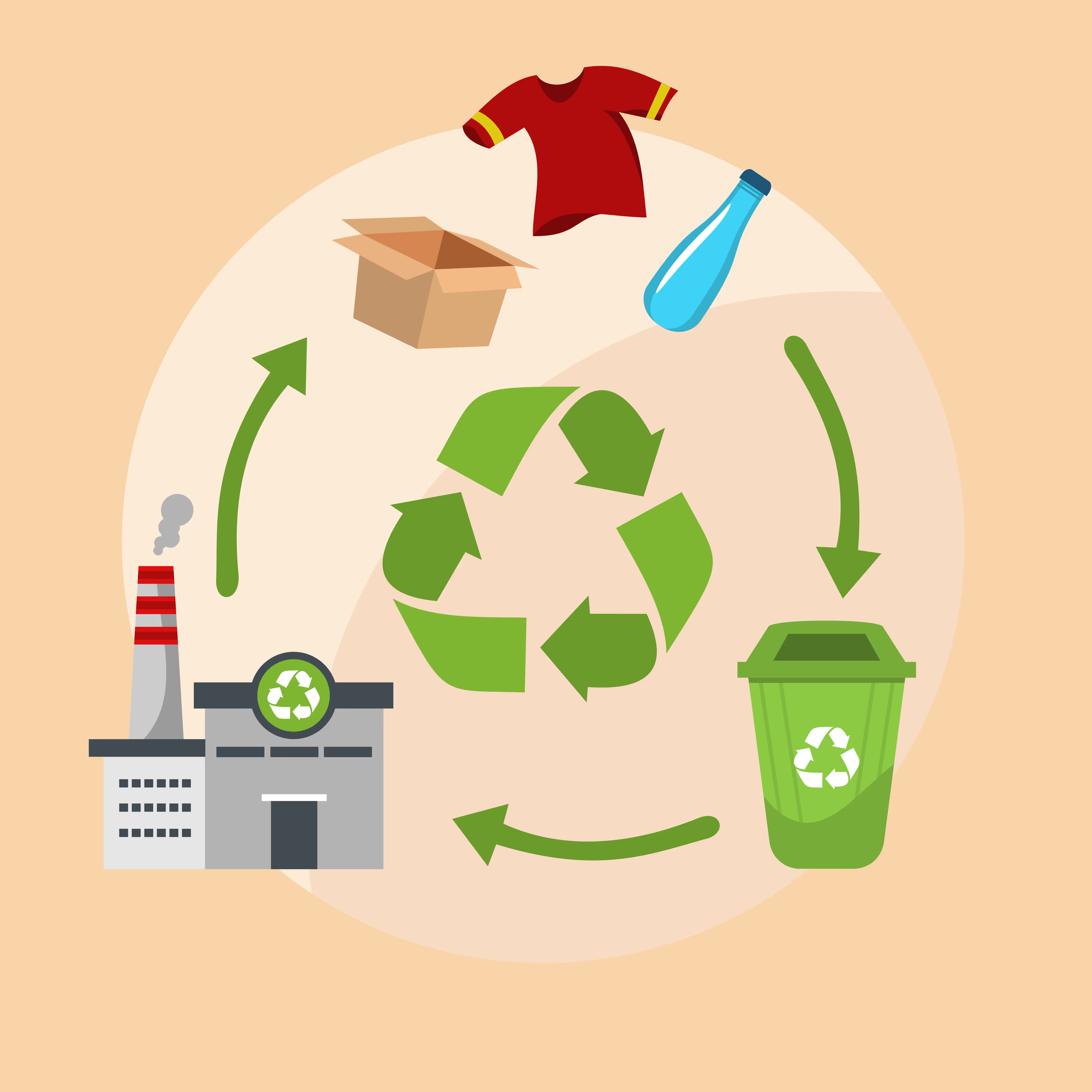Das Konzept der Nachhaltigkeit gewinnt zunehmend an Bedeutung. Aber was genau bedeutet Nachhaltigkeit und wie können wir sie erreichen? Ein einfaches Modell, das uns leiten kann, sind die 6 Rs der Nachhaltigkeit. Diese Rs sind Reduzieren, Wiederverwenden, Recyceln, Umdenken, Ablehnen und Reparieren. Jedes R steht für eine andere Maßnahme, die wir ergreifen können, um unseren Einfluss auf die Umwelt zu verringern und nachhaltiges Leben zu fördern.
Was ist Nachhaltigkeit?
Nachhaltigkeit ist die Praxis, die Bedürfnisse der Gegenwart zu befriedigen, ohne die Fähigkeit zukünftiger Generationen zu gefährden, ihre eigenen Bedürfnisse zu erfüllen. Es geht darum, wirtschaftliche, soziale und ökologische Faktoren in Einklang zu bringen, um den Klimawandel und seine negativen Auswirkungen auf unsere Gesellschaft und den Planeten zu mildern.

Bildnachweis: Unsplash
Im Kern geht es bei Nachhaltigkeit darum, Entscheidungen zu treffen, die uns jetzt und zukünftigen Generationen zugutekommen. Das bedeutet, die Auswirkungen unserer Handlungen auf die Umwelt, die Gesellschaft und die Wirtschaft zu berücksichtigen und bestrebt zu sein, negative Folgen zu minimieren. Es erfordert von uns, unser jetziges Lebensmodell zu überdenken, Praktiken zu übernehmen, die besser mit der Natur im Einklang stehen, und die Menschenrechte zu respektieren.
Was sind die 6 Rs?
Die 6 Rs der Nachhaltigkeit sind Reduzieren, Wiederverwenden, Recyceln, Überdenken, Ablehnen und Reparieren.

Reduzieren
Das erste R, "Reduzieren," bezieht sich auf die Reduzierung der Anzahl der Produkte und Dienstleistungen, die wir nutzen. Dieses Konzept dreht sich um weniger konsumieren, um weniger Abfall zu erzeugen.
Wie können wir dies also in unseren Alltag integrieren? Für Unternehmen kann dies bedeuten, den Energieverbrauch zu reduzieren, indem sie in energieeffiziente Maschinen investieren oder auf erneuerbare Energiequellen umsteigen. Es könnte auch bedeuten, den Materialabfall zu verringern, indem schlanke Fertigungstechniken umgesetzt, Verpackungen überdacht werden, um den Materialeinsatz zu minimieren, oder sogar eine digitale Strategie priorisiert wird, um den Papierverbrauch zu reduzieren.
Nehmen wir zum Beispiel ein Technologieunternehmen, das seinen Energieverbrauch reduziert, indem es seine Rechenzentren in energieeffizientere Cloud-Plattformen zusammenführt. Dies senkt die Betriebskosten und verringert die Umweltauswirkungen des Unternehmens, was mit globalen Nachhaltigkeitszielen in Einklang steht. Indem Unternehmen kontinuierlich nach Optimierungsmöglichkeiten suchen, können sie ihren CO₂-Fußabdruck und die Betriebskosten senken, was die langfristige Nachhaltigkeit fördert.
Wiederverwendung
Wiederverwendung bedeutet einfach neue Möglichkeiten zu finden, um Gegenstände zu nutzen, anstatt sie wegzuwerfen. Es geht darum, die Lebensdauer von Produkten zu verlängern, indem alternative Verwendungen für sie gefunden werden. Anstatt etwas automatisch wegzuwerfen, sollten Sie überlegen, wie es umfunktioniert oder jemandem gegeben werden könnte, der es nutzen kann.
Ein Unternehmen könnte beispielsweise alte Büromöbel wiederverwenden, sie aufbereiten, anstatt neue Möbel zu kaufen, oder veraltete Geräte umfunktionieren für alternative organisatorische Funktionen. Darüber hinaus können Unternehmen Vermögensnutzungsprogramme implementieren, bei denen Geräte oder Materialien, die in einem Bereich nicht mehr benötigt werden, an einen anderen Bereich transferiert werden, anstatt sie wegzuwerfen.
Ein großartiges Beispiel wäre ein Fertigungsunternehmen, das Materialien aus zurückgegebenen oder unverkauften Produkten wiederverwendet. Durch die Zerlegung dieser Artikel können sie verwertbare Komponenten für die neue Produktion gewinnen, wodurch die Notwendigkeit verringert wird, neue Materialien zu beziehen. Dies senkt die Kosten, reduziert Abfall und zeigt ein solides Engagement für die Prinzipien der Kreislaufwirtschaft.
Indem wir alten Gegenständen ein neues Leben schenken, können wir die Menge an Abfall in Deponien erheblich reduzieren. Darüber hinaus ermöglicht das Wiederverwenden uns, unnötige Käufe zu vermeiden, Geld und Ressourcen langfristig zu sparen. Außerdem bietet es die Möglichkeit, kreativ zu werden und innovative Wege zu erkunden, um Alltagsgegenstände umzufunktionieren.
Recyceln
Recycling bedeutet, gebrauchte Materialien in neue Produkte umzuwandeln, wodurch der Bedarf an Rohstoffen reduziert und Abfall minimiert wird. Obwohl Recycling vielen vertraut erscheinen mag, kann die Zugänglichkeit je nach Standort variieren. Unabhängig von lokalen Recyclingprogrammen können Unternehmen jedoch dennoch proaktive Maßnahmen ergreifen, um einen Beitrag zu leisten.
.jpeg)
Recycling ist ein entscheidender Aspekt der Nachhaltigkeit. Es bringt Gegenstände in eine frühere Phase ihres Produktionszyklus zurück, wie zum Beispiel Rohstoffe. Es ist ein Schritt, der nur unternommen werden sollte, wenn eine Wiederverwendung eines Gegenstands nicht möglich ist, weshalb es als das dritte R in der Nachhaltigkeitshierarchie gilt.
Die Bedeutung des Recyclings liegt in seiner Fähigkeit, Ressourcen zu bewahren, die Belastung der natürlichen Ökosysteme zu verringern und das Volumen des Abfalls, der auf Deponien gelangt, zu reduzieren. Durch Recycling mindern wir die Notwendigkeit, neue Ressourcen vom Planeten zu fördern, was zu saubererem Luft und Wasser in unserer Umgebung führt.
Viele Gemeinden bieten Recyclingdienste an der Straße an, um an den Recyclingbemühungen teilzunehmen, während Recyclinganlagen oft zugänglich sind, selbst wenn keine Abholung an der Haustür verfügbar ist. Einige Supermärkte stellen ebenfalls Recyclinganlagen zur Verfügung, insbesondere für elektronische Geräte und Batterien.
Recycling allein reicht nicht aus, um Nachhaltigkeit zu erreichen. Um einen echten Beitrag zum Umweltschutz und zur Ressourcenschonung zu leisten, ist es entscheidend, alle sechs Rs zu berücksichtigen und umzusetzen.
Überdenken
Überdenken fordert Unternehmen auf, einen strategischeren, langfristigen Ansatz für die Nachhaltigkeit zu verfolgen, indem sie traditionelle Praktiken in Frage stellen und die umfassenderen Auswirkungen ihrer Aktivitäten berücksichtigen. Dies umfasst das Überdenken von Geschäftsmodellen, Produktlebenszyklen und Ressourcennutzung, um nachhaltigere Systeme zu schaffen.
Für Unternehmen bedeutet "Rethink", von der Annahme abzurücken, dass Wachstum auf Kosten der Umweltgesundheit erfolgen muss. Stattdessen können Unternehmen durch die Entwicklung von Produkten und Dienstleistungen innovativ sein, die den Ressourcenverbrauch minimieren, die Prinzipien der Kreislaufwirtschaft berücksichtigen und Wert schaffen, ohne unnötigen Konsum.
Ein Unternehmen könnte beispielsweise seine Lieferkette neu überdenken, indem es Materialien lokal beschafft, um die Kohlenstoffeinstellungen aus dem Transport zu reduzieren, oder prüfen, ob die Herstellung eines physischen Produkts durch eine digitale Alternative ersetzt werden kann. Durch die kritische Analyse jeder Phase ihrer Abläufe können Unternehmen Möglichkeiten entdecken, um Prozesse zu verschlanken, Abfall zu reduzieren und der steigenden Nachfrage nach umweltverantwortlichen Geschäftspraktiken gerecht zu werden.
Diese Denkweise ermutigt Unternehmen auch dazu, den Status quo in Frage zu stellen und neue Wege zu finden, um ihren Kunden Wert zu bieten – sei es durch Dienstleistungen, die Ressourcenteilung fördern, Abonnementsmodelle, die den Besitz minimieren, oder Produkte, die auf Modularität und Langlebigkeit ausgelegt sind.
Ablehnen
Lassen Sie uns das fünfte R erkunden: "Ablehnen." Ablehnen bedeutet, aktiv zu entscheiden, unnötige oder nicht nachhaltige Produkte nicht zu kaufen oder zu konsumieren. Ablehnen ermutigt Unternehmen, ihre Lieferkette, Produktionsprozesse und Partnerschaften kritisch zu bewerten und aktiv nicht nachhaltige Praktiken oder Materialien abzulehnen. Unternehmen können ein starkes Beispiel für unternehmerische Verantwortung setzen, indem sie sich entscheiden, nicht mit Produkten, Lieferanten oder Praktiken in Kontakt zu treten, die zur Schädigung der Umwelt beitragen.
Ein Unternehmen könnte beispielsweise ablehnen, nicht-recycelbare oder Einwegverpackungen für seine Produkte zu verwenden. Ebenso können Unternehmen die Partnerschaft mit Lieferanten verweigern, die nicht ethischen oder umweltverantwortlichen Standards entsprechen.
Auf individueller Ebene können Mitarbeiter auch nicht nachhaltige Optionen ablehnen, sei es durch den Verzicht auf plastikintensive Werbeartikel oder durch die Förderung nachhaltiger Alternativen am Arbeitsplatz, wie wiederverwendbare Kaffeebecher oder umweltfreundliches Büromaterial. Dieser Ansatz fördert eine Kultur der achtsamen Entscheidungsfindung, in der sowohl Unternehmen als auch Einzelpersonen nachhaltigere Entscheidungen treffen und Schritte zur Verringerung ihres ökologischen Fußabdrucks unternehmen.
Reparatur
Das sechste R, Reparieren, bezieht sich auf das Reparieren von defekten oder beschädigten Gegenständen, anstatt sie wegzuwerfen. Die Idee ist, die Lebensdauer von Produkten zu verlängern und Abfall zu minimieren, indem Probleme behoben werden, anstatt ganze Gegenstände auszutauschen.
Um ihre Nützlichkeit zu verlängern, können Unternehmen Reparaturprogramme für Maschinen, Technologie und sogar Büromöbel annehmen. Unternehmen können beispielsweise in Reparaturdienstleistungen investieren oder interne Wartungsteams einrichten, um Probleme zu beheben und Anlagen zu renovieren, anstatt defekte Geräte wegzuwerfen. Dieser Ansatz verringert die Umweltbelastung durch die Beschaffung neuer Materialien und die Herstellung neuer Produkte.
Einige Unternehmen gehen sogar noch einen Schritt weiter, indem sie Reparaturdienstleistungen für Kunden anbieten. Technologieunternehmen können beispielsweise Verbraucher dazu befähigen, ihre Geräte durch Reparatursets, Ersatzteile oder Workshops zu reparieren. Dies fördert die Nachhaltigkeit und stärkt die Kundenbindung, indem langfristige Unterstützung für Produkte angeboten wird.
Auf individueller Ebene fördert das Reparieren unsere praktischen Fähigkeiten und Einfallsreichtum. Es befähigt uns, die Kontrolle über unser Eigentum zu übernehmen und aktiv an dessen Pflege und Instandhaltung teilzunehmen (zum Beispiel das Flicken eines Risses in der Kleidung, das Reparieren eines defekten Geräts oder das Ausbessern von Möbeln).
Reparieren fördert auch ein Wertschätzungsempfinden für den Wert und das Handwerk unserer Besitztümer. Indem wir Zeit und Mühe in die Reparatur von Gegenständen investieren, entwickeln wir eine tiefere Verbindung zu den Objekten in unserem Leben und kultivieren eine Denkweise der Nachhaltigkeit und Einfallsreichtum.
Wie wenden Sie die 6 Rs für Ihr Unternehmen an?
Wenn Sie sich fragen, wie Sie die 6 Rs für Ihr Unternehmen anwenden können, finden Sie hier einige praktische Vorschläge:
- Überprüfen Sie Ihre aktuellen Praktiken: Führen Sie eine umfassende Prüfung der Betriebsabläufe Ihres Unternehmens durch, um Bereiche zu identifizieren, in denen die 6 Rs umgesetzt werden können. Bewerten Sie Ihre Verbrauchsmuster, die Abfallgenerierung und die Ressourcennutzung, um Verbesserungspotenziale zu ermitteln.
- Mitarbeiter schulen: Stellen Sie sicher, dass alle Mitarbeiter mit den Prinzipien der 6 Rs vertraut sind und deren Bedeutung für die Nachhaltigkeit verstehen. Sie können Schulungen oder Workshops anbieten, um Ihr Personal darin zu schulen, wie es diese Prinzipien in ihre täglichen Arbeitsabläufe integrieren kann.
- Ermutigen Sie die Mitarbeiter, Abfall zu minimieren: Setzen Sie Maßnahmen um, wie die Verwendung digitaler Dokumente anstelle von Druck, die Reduzierung von Verpackungen für Produkte und die Wahl von energieeffizienten Geräten und Ausstattungen.
- Fördern Sie eine Wiederverwendungskultur: Sie können Mitarbeiter dazu ermutigen, kreative Wege zu finden, um Gegenstände wiederzuverwenden, anstatt sie wegzuwerfen. Richten Sie spezielle Bereiche für wiederverwendbare Büromaterialien ein, wie Stifte, Ordner und Verpackungsmaterialien;
- Denken Sie an ein intelligentes Recyclingprogramm: Stellen Sie deutlich gekennzeichnete Recyclingbins im gesamten Arbeitsplatz bereit und schulen Sie die Mitarbeiter darüber, was recycelbar ist und was nicht.
- Alternative Ansätze erkunden, die Nachhaltigkeit priorisieren: Zögern Sie nicht, Brainstorming-Sitzungen und den Austausch von Ideen unter den Mitarbeitern zu fördern, um innovative Lösungen zur Abfallreduzierung und Ressourcenschonung zu entwickeln.
- Bewerten Sie Ihre Lieferkette und Beschaffungsprozesse: Dadurch können Sie Möglichkeiten identifizieren, unnötige oder nicht nachhaltige Produkte abzulehnen. Priorisieren Sie Lieferanten, die mit den Nachhaltigkeitszielen und Werten Ihres Unternehmens übereinstimmen.
- Implementieren Sie ein Reparatur- und Wartungsprogramm: Sie können die Lebensdauer von Unternehmensvermögen und -geräten verlängern, indem Sie die Mitarbeiter einladen, Probleme umgehend zu melden und zu beheben, um unnötige Ersatzbeschaffungen zu vermeiden.
Die Auswirkungen der 6 Rs der Nachhaltigkeit auf das Verhalten der Kunden
Die 6 Rs der Nachhaltigkeit haben auch einen wesentlichen Einfluss auf das Verhalten der Kunden. Hier ist, was Sie wissen müssen:
- Reduzieren: Kunden werden mit hoher Wahrscheinlichkeit bewusster Kaufentscheidungen treffen, wenn sie sich der Bedeutung der Reduzierung von Konsum und Abfall stärker bewusst werden. Sie könnten sich für Produkte mit minimaler Verpackung entscheiden oder Artikel wählen, die eine längere Lebensdauer haben, was den Bedarf an häufigen Ersatzkäufen verringert.
- Wiederverwendung: Kunden zu ermutigen, das Konzept der Wiederverwendung von Produkten anzunehmen, kann zu einem Umdenken von Einwegartikeln und Wegwerfprodukten führen. Kunden könnten nach wiederverwendbaren Alternativen suchen, wie nachfüllbaren Behältern oder langlebigen Produkten, die für unterschiedliche Zwecke umfunktioniert werden können.
- Recycling: Die Förderung von Recycling-Initiativen kann dazu führen, dass Kunden ihre Abfälle ordnungsgemäß entsorgen und Materialien recyceln, wann immer dies möglich ist. Hier kann Ihr Unternehmen bequeme Recyclingmöglichkeiten bereitstellen oder Anreize für das Recycling anbieten, um die Kunden zur Teilnahme an nachhaltigen Praktiken zu bewegen.
- Überdenken: Indem Unternehmen ihre Kunden dazu anregen, ihre Konsumgewohnheiten zu überdenken, können sie diese erheblich dazu beeinflussen, nachhaltigere Entscheidungen zu treffen. Dies kann die Aufklärung der Kunden über die Umweltwirkungen ihrer Einkäufe beinhalten und sie ermutigen, den Lebenszyklus von Produkten vor einem Kauf zu berücksichtigen.
- Ablehnen: Sie werden vielleicht überrascht sein, aber Kunden dazu zu ermutigen, unnötige oder nicht nachhaltige Produkte abzulehnen, kann zu einem kritischeren Konsumverhalten führen. Kunden könnten selektiver bei ihren Einkäufen werden und sich für Produkte entscheiden, die mit ihren Werten und Prioritäten übereinstimmen.
- Reparatur: Die Förderung von Reparaturdiensten ermöglicht es den Kunden, ihre Produkte zu reparieren, und kann somit eine noch bessere Kultur der Langlebigkeit und Haltbarkeit schaffen. Die Kunden werden eher bereit sein, in hochwertige, einfach reparierbare Produkte zu investieren, anstatt in Wegwerfartikel, die häufig ersetzt werden müssen.
Die drei Säulen der Nachhaltigkeit verstehen

Credits: Plan A
Menschen, die soziale Säule
Das soziale Säule der Nachhaltigkeit konzentriert sich darauf, Gerechtigkeit und Wohlbefinden für alle Mitglieder der Gesellschaft zu gewährleisten. Sie zielt darauf ab, die Bedürfnisse von Individuen zu berücksichtigen und dabei auch das kollektive Wohlergehen der Gemeinschaften zu betrachten.
Diese Säule setzt sich für den allgemeinen Zugang zu grundlegenden Ressourcen und Dienstleistungen ein, unabhängig von sozioökonomischem Status oder geografischem Standort.
Ein wesentliches soziales Säulenprinzip ist sozialer Gerechtigkeit, das Gleichheit, Inklusivität und Menschenrechte fördert. Es erkennt die angeborene Würde und den Wert jedes Einzelnen an und strebt danach, Barrieren abzubauen, die Menschen daran hindern, ihr Potenzial zu entfalten.
Planet, die Umwelt-Säule
Die Umwelt-Säule der Nachhaltigkeit unterstreicht das Gebot, unseren Planeten zu schützen und seine Ressourcen verantwortungsvoll zu verwalten. Sie zwingt uns, Praktiken zu übernehmen, die das ökologische Gleichgewicht fördern, die Biodiversität bewahren und die Auswirkungen menschlicher Aktivitäten auf die natürliche Welt mindern.
Eines der Hauptziele der ökologischen Säule ist es, den Klimawandel anzugehen, indem die Treibhausgasemissionen gesenkt und der Übergang zu erneuerbaren Energiequellen vollzogen wird.
Aber Sie müssen beachten, dass die Umwelt säule auch die Bedeutung von Umweltfreundlichen Praktiken in allen Bereichen des Lebens anzunehmen betont, von der Landwirtschaft und Industrie bis hin zu Transport und Abfallmanagement. Die Ziele sind, die Verschmutzung zu minimieren, Ressourcen zu schonen und einen gesünderen, nachhaltigeren Planeten für kommende Generationen zu fördern.
Gewinn, die ökonomische Säule
Schließlich erkennt die ökonomische Säule der Nachhaltigkeit an, dass Profit nicht der einzige Fokus von Unternehmen sein sollte.
Dieser Säule bedeutet, dass wir die langfristige Lebensfähigkeit wirtschaftlicher Aktivitäten neben ihren Umweltauswirkungen und sozialen Auswirkungen berücksichtigen sollten. Erfolgreiche Unternehmen der Zukunft sind diejenigen, die Profitabilität mit Nachhaltigkeit effektiv austarieren, wobei sie erkennen, dass finanzieller Erfolg mit verantwortungsvollem Ressourcenmanagement und Rücksichtnahme auf das Wohl der breiteren Gemeinschaft verknüpft ist. Das war's!
Starten Sie Ihre Nachhaltigkeitsreise mit Plan A. Vereinbaren Sie noch heute einen Termin.



.jpg)



.avif)

